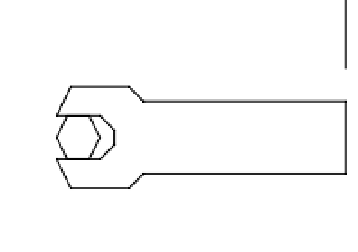Game Development Reference
In-Depth Information
The angular acceleration will have units of
rad/s
2
. The tangential velocity,
v
r
, of any point
on the disk is equal to the angular velocity,
w
, multiplied by the distance,
r
, from the origin to
the point.
v
r
=
wr
(4.30)
The tangential velocity will have units of
m/s
and will be in a direction perpendicular to the
line drawn from the origin to the point.
A rotating object will have an
axis of rotation
, a line about which the object is spinning. In
Figure 4-7, the axis of rotation is the y-axis. The axis of rotation won't always conveniently line
up along one of the coordinate axes, but in general it can be defined by any vector in three-
dimensional space.
Torque
According to Newton's second law, a net external force on an object causes a translational
acceleration of the object. The rotational counterpart of force is
torque
, which causes a rota-
tional acceleration of an object. Torque is defined as a force applied to an object at a certain
distance from an axis of rotation.
t
=
Fr
(4.31)
Torque has units of
N-m
. The distance,
r
, from the center of rotation to the applied force is
called the
moment arm
of the torque. To get a feeling for torque, consider the situation shown
in Figure 4-8, where a wrench is applied to a nut. If a force of 10
N
is applied at a distance of 0.12
m
from the center of the nut, a torque of 1.2
N-m
will be applied to the center of the nut.
F = 10 N
τ = 1.2 N-m
r = 0.12 m
Figure 4-8.
Force applied at a distance from an axis of rotation generates a torque.
When computing torque, it is the force component perpendicular to the moment arm that
is used in the calculation. In Figure 4-8 the force vector and moment arm are perpendicular to
each other, so the full force value of 10
N
is used in the calculation. If the wrench were at an
angle of 30 degrees, as shown in Figure 4-9, and the force was still applied vertically, the force
vector and moment arm would no longer be perpendicular to each other. The perpendicular
force component,
F
p
=
F
cos
30
, would be used in the torque calculation so the torque applied to
the nut would be equal to
Fr
cos
30
= 1.04
N-m
.







